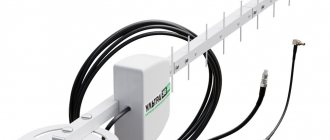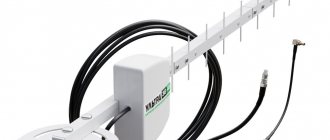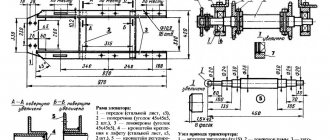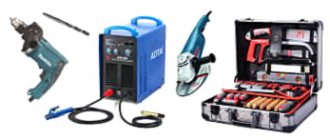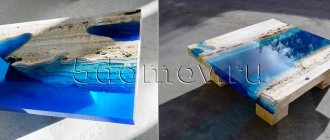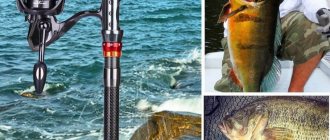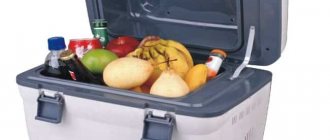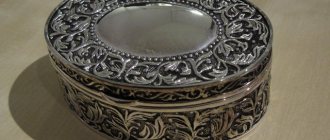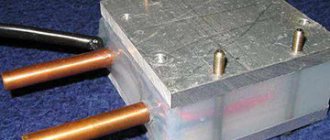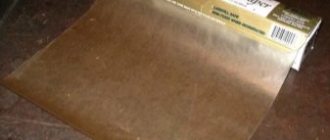Standard
A regular center punch is a metalworking tool made in the form of a handle equipped with a rod, for the manufacture of which special tool steel is used. The purpose of the center punch is to make small indentations in the surface of the metal into which the tip of a drill bit for a hand or electric drill will later be inserted. The punch tip is equipped with a cone-shaped sharpening specifically for the drill. The handle of the device is equipped with special notches. They prevent your hand from slipping while working with the tool. According to consumer reviews, the disadvantage of a conventional punch is that you have to work with two hands (hold a hammer in one, and a punch in the other).
For those who want to free one hand and exert a minimum of effort while working, it is recommended to use an automatic center punch. It can be mechanical, spring and electrical.
What is a center punch?
Those who are familiar with plumbing know what a center punch means. This is a special impact-cutting tool for marking holes called cores. They are made before drilling holes and prevent the drill or screw from slipping from the intended point on the workpiece. This device can core metal, tiles and any smooth surface. The punch must be very durable, so this device is made of hard tool carbon steel.
Core device
A metalworking hand tool, popularly called a poke or core, has the form of a rod with a round or hexagonal cross-section. Its working end is sharpened into a cone having an angle of 100-120° and hardened to a length of 20-30 cm. The sharpening angle is an important indicator: a tool with a sharpened edge is convenient if precise marking of parts is required, and a center punch with a blunt end will facilitate easier drilling metal.
The opposite part of the center punch is the so-called buttplate or firing pin. It bears the brunt of the impact during the operation of the punch, so it is also hardened, but to a length of up to 15 cm. To make the punch more convenient to hold in the hand, its middle part is often made with a special relief knurling (notch). To extend the service life in adverse conditions, decorative and protective coatings in the form of chrome plating can be applied to the marking device.
Spring center punch
A mechanical or spring center punch can be operated with one hand. This tool operates by tightly compressing and self-releasing a special spring.
Inside the body of this tool there is a cocking and trigger mechanism, which affects the firing pin and the working part of the capper. The cone-shaped rod performs punching by hitting it with a striker. It starts moving after the spring is released.
Benefits of the tool
Judging by the reviews of the owners of such products, the spring automatic center punch has the following advantages:
- Marking is done with one hand: no percussion instrument is used.
- The master has the opportunity to control the force of impact with a cone-shaped rod on a metal surface. This function, which the automatic mechanical punch has, allows you to safely process soft and fragile materials without the risk of damaging them: the same depth is a characteristic feature for all holes made by this tool.
- The marking procedure with a mechanical center punch is much faster than with a standard one.
Types of core
This locksmith device is often manual, but there is also an automatic core tool, which is popularly called a crossbow. There are models that have mandrels, with the help of which, for example, marks are quickly formed at a given distance from the edge of the product. There are center punches with special guides that are capable of making holes on a ball or in a cylindrical workpiece. In some spring punches, you can adjust the impact force by turning a special cap in one direction or another.
Mechanical center punch
Such a mechanical device has a built-in spring and striker in its body. When the core is pressed onto the workpiece, the spring is first compressed and then released, which pushes the striker, and it then strikes the surface, leaving a hole on it. The impact tip is replaceable and, if necessary, the worn part can be easily replaced with a new one. A mechanical round rod is more convenient than a manual one, since it allows you to work without exerting much physical effort and use one hand rather than two.
Electric punch
Such an electromechanical tool consists of a housing, inside of which there is an electromagnet coil with a core, a striker, a spring and a tip. When you press the automatic punch, its body lowers. In this case, the washer located on the tip closes the circuit of the electromagnet and the striker, is drawn into the coil with great force, and hits the magnet. This creates a hole in the workpiece. When the center punch is lifted, the chain opens and the striker returns to its original position using a spring. The cost of such a center punch is higher than that of a manual or mechanical one.
Electric automatic punch
The operating principle of this tool is to use a striker and a rod, which are set in motion not by human effort, but by the action of an electrical circuit. With the help of a solenoid (inductance coil) and the created short-term magnetic field, the striker, being drawn into the tool body, releases the firing pin. That, in turn, affects the rod. As numerous consumer reviews testify, using such an automatic punch, you can make at least fifty holes within one minute. As users note, electric cores are rare. This is explained by the fact that these tools have an outdated design.
Where can I buy the device?
You can purchase a center punch of one type or another at locksmith shops. Tools are also sold in the hand and power departments. The cores are cylindrical in shape and are easy to spot on the shelves. Before purchasing this tool, it is recommended to pay attention to what material it is made of and who its manufacturer is. If there are no identification marks on the core body, experienced craftsmen recommend refraining from purchasing this tool.
How to choose a core?
When choosing this locksmith tool, pay attention to the following points:
- What material is it made of?
- Appearance of the center punch.
- Find out the manufacturer of the selected model. It is better to give preference to products from well-known manufacturers.
- Core dimensions. They must be selected taking into account the diameter of the drill.
- Sharpening angle. If you need to drill a hole in a soft material or make particularly precise markings, then the sharpening angle of the center punch, as well as the drill itself, may be smaller.
- Price. When buying a center punch tool, do not go for cheapness and do not take a product without any identification marks.
Kerner rating
Since the center punch plays an important role in carrying out measuring and marking work, it would not hurt to familiarize yourself with the rating of the best models of such plumbing tools:
- KWB 9209-90
. This is a hand tool made by a German company that owns production facilities in China. Being light in weight, this punch is durable and reliable in operation. - STANLEY 0-58-120
. An American instrument made in France. It has increased impact resistance thanks to the square-shaped striker. The disadvantage is the heavy weight. - RENNSTEIG RE-430230
. This is an automatic metal punch made in Germany. Has a comfortable rubberized handle. - JTC 3927
. A relatively cheap option made in Taiwan, which can be used for one-time work. - BISON Expert 21420-10
. The automatic center punch is manufactured in Russia. Easy to use and makes high-quality holes.
German manufacturer
Rennsteig produces contact crimping pliers and impact tools. Chisels, chisels, picks, drifts and punches manufactured by this company are united by high German quality.
Using the Rennsteig automatic punch, marks can be easily made along the marked line. To do this, place the tool in the desired location and press the cap. The punch works itself, without the use of impact devices.
Characteristics
The German product Rennsteig is an automatic center punch, the device of which consists of the following elements:
- Housing made of very high quality tool steel. It has a nickel plating.
- Replaceable hardened tip. Its length is 1.25 cm.
- Drummer. Its diameter is 0.14 cm.
The center punch is also equipped with a mechanism for adjusting impacts.
Using this tool, you can mark both ordinary steel and products made of any non-ferrous metal.
How to make a core with your own hands?
Those craftsmen who love to craft can try making a center punch with their own hands. This locksmith tool will save money and will be in no way inferior to a factory product, and it can be made, for example, from an ordinary bolt with a diameter of 14 mm. The core production work consists of the following stages:
- We clamp the bolt on a lathe and grind its end into a cone, sharpening the lower edge.
- We weld a piece of reinforcement or steel rod to the middle of the bolt.
- We put a wooden handle on the edge of the workpiece, which you can remove from an old file or chisel, or you can make it yourself.
- We harden the pointed end of a homemade center punch. To do this, heat the tip of the bolt on a gas burner and then dip it into a vessel with mineral oil.
- Allow the product to cool and you can use the resulting plumbing tool, which will be useful in any home workshop.
Do-it-yourself automatic center punch
Those who want to get a device for markings, but at the same time save money, or just those who like to tinker, can try to make a standard core. A regular diesel injector is suitable for this purpose, namely its shut-off needle, which is highly hard. It can freely core plastic, aluminum, copper, brass, bronze and high-carbon non-hardened tool steels. For those who want to work without using hammers, it is better to make an automatic core from a duralumin pipe. To work you will need:
- A duralumin pipe with a diameter of 0.12 cm. It will become the body of the future product.
- Shock-cocking mechanism. It is a cone-shaped product made of durable carbon steel, which is located at a slight offset inside the charging spring.
- Ordinary spring. It should be placed between the striker and the core plug.
- Cover or plug. It acts as a stop for the trigger spring, which acts on the firing pin.
- Striker. It is easy to sharpen it yourself using a sharpening machine or grinder.
- Sharpened cone-shaped rod. There may be several of them. In this case, if necessary, during work they can be removed and sharpened one by one.
Do-it-yourself automatic center punch
Any metalworking operation is preceded by marking the part with lines and reference points deepened into the surface of the metal. The first ones are done with scribers, and for applying the second ones there is a special marking tool - a center punch. In general form, it is a small metal cylinder with a sharpened working end and a flat back.
GOST punches are made of rolled rods of alloy and carbon tool steels. In conventional punches, the marking point (core) is applied by hitting a hammer, while in mechanical automatic punches a spring and a striker are used for these purposes.
This tool has a more complex design, but is highly accurate and allows you to work with one hand. In addition to spring ones, there are automatic electric and pneumatic punching devices. They are much more expensive than conventional and mechanical punches, so they are used in industrial production with large volumes of marking work.
A specialized tool for applying cores allows automatic alignment on similar parts or cylindrical surfaces.
Progress
It is not difficult to make an automatic core yourself if you work in stages. The wizard is required to perform the following actions:
- Make a punch rod. It is desirable that it have a diameter of 0.4 cm and a length of 4 cm. The working surface must be hardened.
- A shock-absorbing washer is installed on the striker shank. After this action, it is considered ready for use.
- Prepare the firing mechanism. To do this, install a machined part in the form of a cone in the inner part of the spring. This work should be performed in such a way that the thin part (0.3 cm) of the part rests against the end of the striker. Its length can be 3 cm.
- Insert the trigger mechanism into the body of the future tool.
- The upper part of the pipe closes silently at the end. For this purpose, the tube is equipped with a thread onto which the cap is screwed.
As a result, a homemade punch should act as follows:
- A sharpened cone-shaped rod is placed at the intended location for punching, after which it should be pressed.
- With its second blunt end it acts on the trigger mechanism: it pushes a cone-shaped part installed in the spring towards the firing pin.
- As a result of pressing the rod on the trigger mechanism, its cone-shaped part gradually moves more and more from the end until it hits the center of the firing pin. He, being under the influence of an ordinary spring, performs the blow.
The manufacture of a product can be considered successfully completed if, when the rod is pressed at the desired point, a mark is immediately formed on the surface. As numerous reviews from owners testify, it is convenient to store homemade cores and cores in chess boards. There, for each rod, you can make special sections made of polystyrene foam.
Homemade cores, both conventional and automatic, are the optimal solution for those who use this tool only occasionally.
